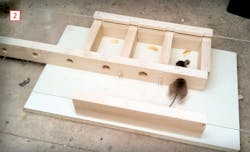How Small a Hole Is Too Small for a Mouse?
Living in the country, mice are a fact of life. I was curious how small a hole a mouse could get through. In the past I had experimented with a mouse maze that included a 19-mm (¾-inch) hole that was no problem for the mice. So the question was: How small a hole is too small for a mouse to get through?
The Apparatus
To find out, I built a device that has three cubbies, a board in front with different-sized holes, and a transparent cover [1]. I can move the board to adjust which hole sizes the mouse can try to get through to reach some peanut butter I put in the cubbies.
I set this up in a shed where I don’t mind mice as much as I do in the house or in the workshop. The set-up was illuminated continuously by some LED strips, and monitored constantly by a Raspberry Pi computer with a camera module that saved images whenever it detected any motion.
Unfortunately, the mice were not willing to play this game. One went through the 17.5-mm hole (which had been done earlier), but despite trying mightily, it couldn’t fit through the 17-mm hole [5]. Eventually it gave up, eating only the easily accessible peanut butter that I kept adding as bait. When I stopped adding peanut butter that could be reached easily, the mice went away entirely for about two weeks. When a mouse came back, I started adding peanut butter again, but it once again figured out that it could get peanut butter without actually trying to go through the smaller holes.
An Unexpected Visitor
Then one night another creature showed up. At first I thought it was a mole, but it was actually a shrew. Shrews look similar to moles but their front paws aren’t as large.
The shrew tried getting through the holes with much more enthusiasm than the mice, but its larger size was a problem. With persistence, however, and a lot of wriggling and squirming, it was able to get through not just the 17.5-mm hole, but even the smaller 17-mm hole [6], which the mouse hadn’t been able to get through! Even better, the shrew returned not long after I posted the original video of the experiment on my website, and managed to squeeze itself through the 16.5-mm hole [7] (just a bit larger than 5/8 inch)!
How Small is Too Small?
Although mice reappeared occasionally, the shrew had already eaten most of the easily accessible peanut butter, and the mice seemed uninterested or too lazy to try the smaller holes. Nevertheless, I’m pretty sure an enterprising mouse could get through holes smaller than 17 mm, but I think a 13-mm hole (about ½-inch) is probably too small for an adult mouse.





